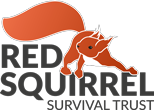RSST AND ROYAL PHOTOGRAPHIC SOCIETY NATURE GROUP
During our Photography competition for 2020, we became aware that certain images may be being obtained through practices that we, RSST, do not subscribe to. Moving forward we would like to share our views on image capture and use, and we hope that they are understood and honoured by all connected with Red Squirrel Conservation, photographers, photographic groups and clubs alike. First and foremost, we are about nature. Images of Red Squirrels play a vital ambassadorial role in heightening general public awareness of their plight so long as there is a sound ethical basis to capturing them. However, if the manner in which the images are obtained compromises the nature and safety of the animal then this is simply not acceptable.
The Royal Photographic Society Nature Group, have a prescriptive code of ethical practice to which we wholeheartedly subscribe and would encourage all red squirrel photographers to acknowledge. https://rps.org/media/1xcnsuga/the-nature-photographers-code-of-practice.pdf
In their introduction they highlight the following statement:
“There is one hard and fast rule, whose spirit must be observed at all times. “The welfare of the subject is more important than the photograph.”
In future, we may refuse images that are clearly not in line with the above code of practice, or not in line with any or all of the broad concerns below:
- Baiting or enticing with unnatural foods or excessive baiting: This practice has many potentially negative, threatening or deadly outcomes. Red squirrels can become reliant on human feeding and less able to fend for themselves. Predators become accustomed to their regular presence. Grey squirrels begin to appear due to the proliferation of food, bringing SQPV risks among others.
- Enticement to close proximity or interaction with humans: Effectively taming them, it introduces increased risk of them being run over in car parks, vulnerable to dog attacks etc.
- Use of any unnatural props backgrounds or locations: In our view, such images have little to do with nature and are purely for social media and or commercial intentions.
It should be the responsibility of any true nature photographer to understand the natural history of the subject sufficiently so as not to endanger the animal in their pursuit of an image/film, in other words;
If in doubt, don’t.
We would encourage land/park/woodland/nature reserve owners to adopt practices that allow nature photography to be conducted safely for example:
- Don’t allow animals to be enticed close to human contact, particularly car parks.
- Create hides with feed stations using natural feed.
- Ban indiscriminate feeding
- Provide clear signage and enforcement as needed.


